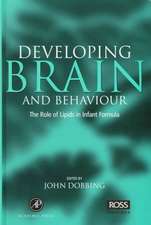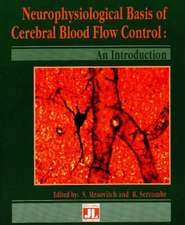Neurosensory Disorders in Mild Traumatic Brain Injury
Editat de Michael E. Hoffer, Carey D. Balabanen Limba Engleză Hardback – 9 ian 2019
- Provides a comprehensive examination of the neurosensory issues associated with mild Traumatic Brain Injury and concussion
- Brings together both the basic science work and the clinical work in mTBI into a single volume
- Helps clinicians understand the best diagnosis and treatment paths and puts current research into perspective for researchers
Preț: 699.64 lei
Preț vechi: 947.23 lei
-26% Nou
Puncte Express: 1049
Preț estimativ în valută:
133.89€ • 139.27$ • 110.54£
133.89€ • 139.27$ • 110.54£
Carte tipărită la comandă
Livrare economică 07-21 aprilie
Preluare comenzi: 021 569.72.76
Specificații
ISBN-13: 9780128123447
ISBN-10: 0128123443
Pagini: 452
Dimensiuni: 191 x 235 x 24 mm
Greutate: 1.11 kg
Editura: ELSEVIER SCIENCE
ISBN-10: 0128123443
Pagini: 452
Dimensiuni: 191 x 235 x 24 mm
Greutate: 1.11 kg
Editura: ELSEVIER SCIENCE
Cuprins
Section 1: Defining Mild TBI
1. What is Mild TBI? Translational Definitions to Guide Translational Research (will include historical perspectives)
2. Clinical trajectories of mild TBI
3. Disentangling Peripheral and Central Neurosensory Processing Effects
4. Defining a “cure: when is the patient “good-to-go
5. Concussion Center Dynamics for Diagnosis and Treatment
Section 2: Overview of Neurosensory Consequences
6. Neurosensory Disorders in Animal Models of blunt trauma mTBI
7. Neurosensory Disorders in Animal Models of blast mTBI
8. Neurosensory Symptom Clusters: Sense-Making and Story Lines
9. Neurosensory, neuropsychological and psychiatric co-morbidities in mTBI
10. Neurosensory manifestations of tauopathies and other neurodegenerative sequelae
Section 3: Neurosensory Disorders in Clinical Practice
11. Balance Disorders associated with mTBI
12. Hearing Disorders associated with mTBI
13. Headaches and mTBI
14. Cognitive Issues and mTBI
15. Sleep Issues and mTBI
16. Smell and Taste Disorders in mTBI
17. Visual processing disorders in mTBI
18. Autonomic nervous system and mTBI
Section 4: Diagnosis and Treatment
19. Overview of Current Techniques
20. Neurosensory Diagnostic Techniques for mTBI: Field and Clinic
21. Radiologic and Functional Imaging in mTBI
22. Current Treatment Modalities for mTBI
23. Vestibular Rehabilitation for mTBI
24. Cognitive Rehabilitation for mTBI
25. Emerging Diagnostic Modalities
26. Emerging Treatment Modalities
1. What is Mild TBI? Translational Definitions to Guide Translational Research (will include historical perspectives)
2. Clinical trajectories of mild TBI
3. Disentangling Peripheral and Central Neurosensory Processing Effects
4. Defining a “cure: when is the patient “good-to-go
5. Concussion Center Dynamics for Diagnosis and Treatment
Section 2: Overview of Neurosensory Consequences
6. Neurosensory Disorders in Animal Models of blunt trauma mTBI
7. Neurosensory Disorders in Animal Models of blast mTBI
8. Neurosensory Symptom Clusters: Sense-Making and Story Lines
9. Neurosensory, neuropsychological and psychiatric co-morbidities in mTBI
10. Neurosensory manifestations of tauopathies and other neurodegenerative sequelae
Section 3: Neurosensory Disorders in Clinical Practice
11. Balance Disorders associated with mTBI
12. Hearing Disorders associated with mTBI
13. Headaches and mTBI
14. Cognitive Issues and mTBI
15. Sleep Issues and mTBI
16. Smell and Taste Disorders in mTBI
17. Visual processing disorders in mTBI
18. Autonomic nervous system and mTBI
Section 4: Diagnosis and Treatment
19. Overview of Current Techniques
20. Neurosensory Diagnostic Techniques for mTBI: Field and Clinic
21. Radiologic and Functional Imaging in mTBI
22. Current Treatment Modalities for mTBI
23. Vestibular Rehabilitation for mTBI
24. Cognitive Rehabilitation for mTBI
25. Emerging Diagnostic Modalities
26. Emerging Treatment Modalities
















